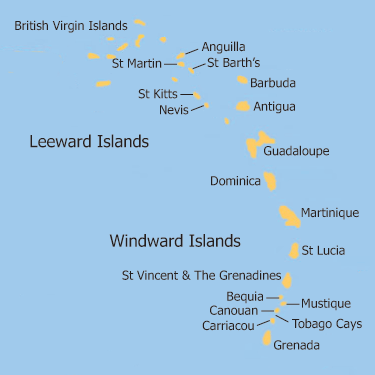Email: info@secondstarsailing.com »
Tel: +39 320 223 7822 Just call us in Italy via WhatsApp!
Click on an island name for our guide
Please see our Inter Island Options page for suggestions of which destinations can be included in a charter.
The islands of the Caribbean were shaped by volcanic activity thousands of years ago. The result is a chain of islands that stretch over 2,000 miles, with the Atlantic to the East and Caribbean Sea to the West.
Every Caribbean island has its own unique character shaped not only by its colourful history but also by its topography. From the unspoilt rainforest and black sandy beaches of Dominica to the European influenced St Kitts with its old plantation houses and glamorous hotels, all islands have something unique to offer.
Exploring the Caribbean by yacht is a wonderful way to appreciate each island’s unique qualities and also enjoy the wonderful tropical climate. By day enjoy swimming through coral reefs, or going ashore and visiting anything from waterfalls to rum factories. Then by night try a new cuisine and experience island life before returning to your yacht for a well-deserved rest.
Miramar Sailing will help you tailor your dream Caribbean Sailing Vacation.
The British Virgin Islands
![]() The Virgin Islands are politically split into the US Virgin Islands situated in the southern group and the British Virgin Islands in the northern region. The BVI’s consist of 4 main islands and 50 smaller islands and cays, only 15 of which are inhabited. Steeped in British naval history, the waters are home to many ship wrecks, making for wonderful exploratory diving as well as adventurous sailing.
The Virgin Islands are politically split into the US Virgin Islands situated in the southern group and the British Virgin Islands in the northern region. The BVI’s consist of 4 main islands and 50 smaller islands and cays, only 15 of which are inhabited. Steeped in British naval history, the waters are home to many ship wrecks, making for wonderful exploratory diving as well as adventurous sailing.
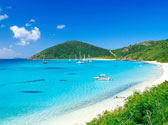 Tortola is the capital of the BVI’s and a good place to start your exploration of the string of islands. It has everything to offer you would expect from a Caribbean island, beautiful beaches, tropical warm waters and a relaxed atmosphere.
Tortola is the capital of the BVI’s and a good place to start your exploration of the string of islands. It has everything to offer you would expect from a Caribbean island, beautiful beaches, tropical warm waters and a relaxed atmosphere.
Virgin Gorda is best reached by boat, from here you can explore the luxurious hotels, restaurants and yacht clubs. Richard Branson’s Necker island is just offshore. The rock formations of the Baths are a big attraction, followed by a hike over the Virgin Gorda Peak and the trail to Devil’s Bay. If you are happier on the water then a trip to the Bitter End Yacht Club and Saba Rock to have a drink and chat with fellow sailors is the option for you.
Anegada is the only coral reef island of the BVI’s. Its infamous Horseshoe Reef caused over 300 shipwrecks in the early years. Divers and snorkelers are now spoilt for choice in the crystal clear waters. Anegada is home to giant iguanas and flamingos and blooming cacti. It is a beautiful island far away from the trappings of 21st Century life, with just a few simple restaurants and hotels. It is hard not to slow down and enjoy Anegada.
Jost Van Dyke island, named after a Dutchman is just 4 sq miles. Home to Great Harbour and its world famous yacht parties, a visit to Foxy’s Tamarind Bar is a fun lover’s “must do”! Alternatively explore the old sugar mills and trails that cross the island. A famous export is ‘The Painkiller’ cocktail made in The Soggy Dollar Bar.
The BVI’s offers incredible sailing, stunning waters and memorable parties all in tropical sunshine!
Leeward Islands
![]() Anguilla celebrates a rich history. Many tribes and cultures passed through this island, one such tribe were the Arawaks who occupied the island over 3,000 years ago. Examples of their deep religious beliefs are still evident in cave art at Big Springs, Island Harbour. From the late 1600’s, the British set up successful plantations in cotton, tobacco, mahogany, rum and sugar cane. Wallblake House is the last standing plantation house and is worth a visit. It was not until 1980 that Anguilla celebrated full independence.
Anguilla celebrates a rich history. Many tribes and cultures passed through this island, one such tribe were the Arawaks who occupied the island over 3,000 years ago. Examples of their deep religious beliefs are still evident in cave art at Big Springs, Island Harbour. From the late 1600’s, the British set up successful plantations in cotton, tobacco, mahogany, rum and sugar cane. Wallblake House is the last standing plantation house and is worth a visit. It was not until 1980 that Anguilla celebrated full independence.
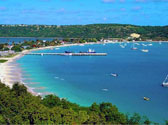 Sandy Ground, is a sleepy village by day, but at night turns into Anguilla’s ‘entertainment capital’. Bars and restaurants buzz with music, dancing and general merriment. If you prefer a more sedate evening, enjoy the sunset from Crocus Hill, Anguilla’s highest point and visit the fine dining restaurant.
Sandy Ground, is a sleepy village by day, but at night turns into Anguilla’s ‘entertainment capital’. Bars and restaurants buzz with music, dancing and general merriment. If you prefer a more sedate evening, enjoy the sunset from Crocus Hill, Anguilla’s highest point and visit the fine dining restaurant.
Shoal beach is the place to participate in snorkelling, scuba diving or just relaxing in the breath taking blue waters. The nearby fishing village, Island Harbour, is definitely worth a visit to watch the fisherman at work and to sample some of the local cuisine.
Boat racing is Anguilla’s national sport and passion. Racing takes place throughout the season, with the culmination of the Champion of Champions in August where spectators line the beach roads to cheer on their team.
Anguilla’s warmth and charm make it a great Caribbean destination.
 Saint Martin and Sint Maarten are 2 distinct districts, the former is French and the latter recently acquired independence from the Dutch. There are 40 beaches, over 300 restaurants, plus great shopping all packed into the island so you will have plenty to do however long your stay.
Saint Martin and Sint Maarten are 2 distinct districts, the former is French and the latter recently acquired independence from the Dutch. There are 40 beaches, over 300 restaurants, plus great shopping all packed into the island so you will have plenty to do however long your stay.
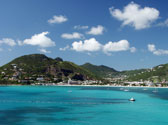 The small town of Grand Case is known as the ‘Gourmet Capital of the Caribbean’, the road runs adjacent to the sea with all the restaurants on the one strip. There is a full range of places to eat from simple fare to fine dining. A visit to the Sunset Beach bar in Sint Maarten is a must for any visitor, made famous due to its close proximity to the airport. People can be seen hanging on the perimeter fence to experience the full force a Jumbo Jet’s engines as they take off at the very end of the runway.
The small town of Grand Case is known as the ‘Gourmet Capital of the Caribbean’, the road runs adjacent to the sea with all the restaurants on the one strip. There is a full range of places to eat from simple fare to fine dining. A visit to the Sunset Beach bar in Sint Maarten is a must for any visitor, made famous due to its close proximity to the airport. People can be seen hanging on the perimeter fence to experience the full force a Jumbo Jet’s engines as they take off at the very end of the runway.
The best way to get an idea of the island is from the sea, as by sailing around you can visit the satellite islands of Ilet Pinel or Tintamarre. There are plenty of quiet and picturesque beaches to visit like Friar’s Bay and Baie Longue or, if you are after more of a buzz, try Orient Beach which has a real tourist feel.
This island is unique in what it has to offer the passing visitor, the tourist board sums it up nicely, ‘a little bit of European and a lot of Caribbean’.
![]() Saint Barthelemy or “St Barths” as it is more commonly known, has the reputation as the playground of the rich and famous. This 8 mile island packs in over 20 beaches and an impressive range of restaurants and hotels.
Saint Barthelemy or “St Barths” as it is more commonly known, has the reputation as the playground of the rich and famous. This 8 mile island packs in over 20 beaches and an impressive range of restaurants and hotels.
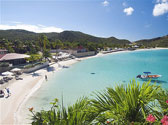 Gustavia has the feel of St Tropez, with its designer boutiques and upmarket restaurants. ‘Le Select’ is the cheapest meal you will find, with BBQ food and beer ordered from the quaint bar, it is perfectly situated to watch the world go by. The old Fort Gustave is worth a visit, and across the bay is Fort Oscar from where you will see the islands of St Kitts and Sint Eustatius on a clear day.
Gustavia has the feel of St Tropez, with its designer boutiques and upmarket restaurants. ‘Le Select’ is the cheapest meal you will find, with BBQ food and beer ordered from the quaint bar, it is perfectly situated to watch the world go by. The old Fort Gustave is worth a visit, and across the bay is Fort Oscar from where you will see the islands of St Kitts and Sint Eustatius on a clear day.
St-Jean is a tourist heavy town, the home to many good hotels and restaurants and a very nice beach. Further along is the Grand Cul-de-sac which has a beautiful beach great for water sports. A must see is Lorient, the site of the first French settlement.
Anse de Colombia is a secluded cove which can be reached via a coastal walk or by boat. It offers stunning turquoise waters ideal for snorkelling and swimming. Shell Beach can be reached on foot from Gustavia where again you could see the islands of St Eustatius, Saba and St Kitts.
The Festival of St Barth’s on 24th August is the patron saint’s feast day. Islanders celebrate with fireworks, feasting and boat races.
A visit to St Barth’s gives the opportunity to dip a toe into Caribbean glamour without blowing the budget!
“The Islands that Brush the Clouds”
![]() The two island nation of St Kitts and Nevis offers a bit of something for everyone. The beaches and bars of St Kitts, along with its history in sugar, make it a real tourist buzz. The quieter neighbour of Nevis offers nature trails and a few good beaches.
The two island nation of St Kitts and Nevis offers a bit of something for everyone. The beaches and bars of St Kitts, along with its history in sugar, make it a real tourist buzz. The quieter neighbour of Nevis offers nature trails and a few good beaches.
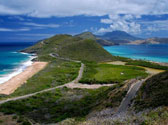 St Kitts and Nevis are the oldest British colony and did not become a single nation with the British Commonwealth until 1983. The British occupation is mirrored in the architecture and of course the national sport, cricket.
St Kitts and Nevis are the oldest British colony and did not become a single nation with the British Commonwealth until 1983. The British occupation is mirrored in the architecture and of course the national sport, cricket.
Basseterre, the capital, should be explored, but be mindful of the port which gets clogged with cruise ship passengers. There are plenty of colonial buildings and the National museum provides an introduction to the island’s history.
A tour around northern St Kitts will take in the mountains, plantations and dramatic coastline. The St Kitts Scenic Railway will take you part of the way with the rest of the journey via bus. The Brimstone Hill Fortress is a recognised Unesco site and is a historical highlight, it gives a great insight into the turbulent past of the colony.
Nevis is just a compact version of its sister island and can be circumnavigated in a couple of hours. There are good hikes into the rain forest, culminating in Nevis Peak which offers beautiful views of surrounding villages and the vegetation. The Horatio Nelson Museum which as the name suggest has artefacts of when he was resident and also other related Nevis material. In addition there are Botanical gardens which cover 8 acres which boast a wide variety of botanical life.
St Kitts & Nevis gives a taste of colonial Caribbean with the trappings of 21st Century living.
“The Islands of Mountains & Mangroves”
![]() Barbuda is a pleasant 5 hour sail from Antigua and can hardly be seen on the horizon until you are almost on it due to being so low lying. This small island has a very different feel to its neighbour Antigua, mainly due to having only 1250 population. A very relaxed and warm Caribbean welcome is given to all visitors, as they arrive either by boat or small plane
Barbuda is a pleasant 5 hour sail from Antigua and can hardly be seen on the horizon until you are almost on it due to being so low lying. This small island has a very different feel to its neighbour Antigua, mainly due to having only 1250 population. A very relaxed and warm Caribbean welcome is given to all visitors, as they arrive either by boat or small plane
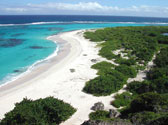 Barbuda is home to the largest frigate bird sanctuary in the Caribbean. You can take a tour with an experienced guide around the nesting area in the shallow lagoon. The island is also home to pelicans, ibis, herons and numerous other birds as well as wild boar and deer.
Barbuda is home to the largest frigate bird sanctuary in the Caribbean. You can take a tour with an experienced guide around the nesting area in the shallow lagoon. The island is also home to pelicans, ibis, herons and numerous other birds as well as wild boar and deer.
Next stop is the 11 mile pink beach, pink from conch shells that are crushed on the reef and washed ashore over time. In some lights the beach takes on a magical pink glow, and it is rare to see any other people there!
For some native history visit the Arawak caves where after a short climb you can see cave art dating back thousands of years. Also the views from the top of the cliff are stunning.
For a spot of lunch there are several wonderful Caribbean beach bars that will serve up fresh lobster and a cold beer, then sit back and snooze in the shade like the locals, or go for a snorkel out on the reef. The Lighthouse Bay is Barbuda’s only luxury hotel and is situated opposite the Frigate Bird Sanctuary.
Barbuda is a place you go to get away from it all.
![]() The island of Antigua boasts 365 beaches, one for every day of the year, but there is a lot more to this beautiful island than white sand and crystal blue sea. Lush green rainforest nestles in the south west corner of the island, visitors can explore the interior on several well organised tours, or the more adventurous can zip-line through the canopy.
The island of Antigua boasts 365 beaches, one for every day of the year, but there is a lot more to this beautiful island than white sand and crystal blue sea. Lush green rainforest nestles in the south west corner of the island, visitors can explore the interior on several well organised tours, or the more adventurous can zip-line through the canopy.
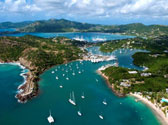 Antigua is also home to the only working Georgian dockyard in the world, Nelson’s Dockyard in English Harbour, which is a World Heritage site. Founded by Admiral Lord Nelson in the 1700’s it is now a hub for tourists and film crews alike! Only a short drive away is Shirley Heights, a lookout point used by the British Navy during Nelson’s time. It now provides panoramic views of English and Falmouth Harbour, along with views across to Nevis and Guadeloupe. A Sunday night “Lime” is a great opportunity to enjoy the sunset, drink the local rum and enjoy a BBQ and make new friends.
Antigua is also home to the only working Georgian dockyard in the world, Nelson’s Dockyard in English Harbour, which is a World Heritage site. Founded by Admiral Lord Nelson in the 1700’s it is now a hub for tourists and film crews alike! Only a short drive away is Shirley Heights, a lookout point used by the British Navy during Nelson’s time. It now provides panoramic views of English and Falmouth Harbour, along with views across to Nevis and Guadeloupe. A Sunday night “Lime” is a great opportunity to enjoy the sunset, drink the local rum and enjoy a BBQ and make new friends.
Antigua hosts many sailing events throughout the season, with the Classic Yacht Regatta and Antigua Sailing Week in April being the highlight. The island comes alive with spectators and competitors alike and is really something not to be missed. A Caribbean carnival is a real experience for any visitor and Antigua’s August offering is no different. Over a 4 day public holiday the streets come alive with floats, parades, street food, music and dancing.
A tour around the capital St John, is an opportunity to see how Antiguan’s go about their everyday business. Visit the bustling food market and sample some local cuisine, visit Heritage and Redcliff Quay for souvenirs and duty free and then if you still have energy take a walk to the Antigua & Barbuda Museum which gives a potted history of the island.
There is accommodation to suit all tastes and budgets; from upmarket resorts and hotels to more intimate and quieter boutique hotels and private guest houses. Antigua is not short of night life, several nightclubs and bars stay open till the sunrise. There are also plenty of fantastic restaurants to sample Caribbean and more International flavours, as well as fine dining.
So whether you choose to stay just for a few days or several weeks Antigua has plenty to offer individuals, couples and families alike.
![]() Guadeloupe is a fantastic mix of everything French with a Caribbean flare and one of the most developed islands in the Caribbean. This island forms the shape of butterfly wings, with two river divided land masses, Grande-Terre and Basse-Terre. Both “wings” with much to offer.
Guadeloupe is a fantastic mix of everything French with a Caribbean flare and one of the most developed islands in the Caribbean. This island forms the shape of butterfly wings, with two river divided land masses, Grande-Terre and Basse-Terre. Both “wings” with much to offer.
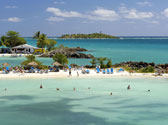 Grand-Terre consists of a string of beach towns with bars, surf schools and turquoise waters. The western wing, Basse-Terre is the home of the national park with La Soufriere volcano at its heart. This ‘wing’ offers hiking for all levels with well laid out paths and information, it is not essential to have a guide. A group of archipelagos south of the main land offer further opportunity for exploration which is perfect by boat.
Grand-Terre consists of a string of beach towns with bars, surf schools and turquoise waters. The western wing, Basse-Terre is the home of the national park with La Soufriere volcano at its heart. This ‘wing’ offers hiking for all levels with well laid out paths and information, it is not essential to have a guide. A group of archipelagos south of the main land offer further opportunity for exploration which is perfect by boat.
Swimmers and snorkelers will not be disappointed; Guadeloupe offers countless beaches and a varied marine life. The waters around Pidgeon Island are protected thanks to Jacques Cousteau who claimed them as one of the world’s best dive sites. The Reserve Cousteau can be reached by a short boat ride from the main land.
A visit to Chutes du Carbet is a must with stunning views of two waterfalls. On the way you can also visit Grand Etang a beautiful lake with a trail around its edge. In addition, a visit to Deshaies Botanical Gardens, with its fabulous restaurant is a great afternoon out for walking around this exquisite tropical garden.
Cuisine is how you would expect it to be, good French cooking with a Creole twist. The dining options are bountiful. There are several rum tours on offer, watching the work that goes into making this famous Caribbean tipple is quite daunting and well worth it.
Guadeloupe offers the Caribbean experience with a French accent.
![]() Dominica is a beautiful rugged island with breath taking views, tropical rainforest and dramatic coastlines. It offers some of the best hiking the Caribbean has to offer, there is something for all levels and abilities. The waters that surround this island offer wonderful diving opportunities. At the right time of year you can see whales migrate along the coast. Many beaches are hard to get to from land, but Dominica is not about sitting on a sandy beach, it is about exploring its mountainous heart and getting back to nature.
Dominica is a beautiful rugged island with breath taking views, tropical rainforest and dramatic coastlines. It offers some of the best hiking the Caribbean has to offer, there is something for all levels and abilities. The waters that surround this island offer wonderful diving opportunities. At the right time of year you can see whales migrate along the coast. Many beaches are hard to get to from land, but Dominica is not about sitting on a sandy beach, it is about exploring its mountainous heart and getting back to nature.
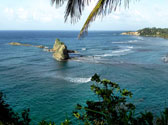 Dominica is the home to the Carib Indian population, the last remaining community of pre-Columbian times. You can visit the Carib territories where the local villagers sell handmade souvenirs to passing tourists.
Dominica is the home to the Carib Indian population, the last remaining community of pre-Columbian times. You can visit the Carib territories where the local villagers sell handmade souvenirs to passing tourists.
The Morne Trois Pitons National Park is a Unesco World Heritage site. Visits to the Emerald Pool, Boiling Lake and Trafalgar Falls are a must, but will take several days to do all 3 with the Boiling Lake taking a day alone. Swim in the Titou Gorge which is a deep pool warmed by hot springs and is quite an adventure. For the real adventures you can go canyoning and climb and jump off the many waterfalls!
The capital Roseau is worth a visit to wander around its bustling streets and visit the market and sample some local food. There is also an informative museum which will give a good history of the island. Private boats can take you up the Indian River, made famous as a scene set in “Pirates of the Caribbean”.
Dominica is about life on Caribbean time and enjoying a landscape that has not changed for thousands of years.
Please see our Inter Island Options page for suggestions of which destinations can be included in a charter.
Windward Islands
![]() Martinique is sophisticated France in the Caribbean. The original capital of St Pierre was known as the ‘Little Paris of the West Indies’, but was wiped out by the island’s volcano ‘Mont Pelee’ in 1902, the volcano is still active today.
Martinique is sophisticated France in the Caribbean. The original capital of St Pierre was known as the ‘Little Paris of the West Indies’, but was wiped out by the island’s volcano ‘Mont Pelee’ in 1902, the volcano is still active today.
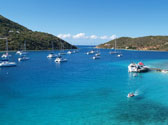 There is plenty of variety in Martinique. The northern end of the island is dense with lush rainforests with the south home to beautiful hidden bays. For water sports enthusiasts try surfing at Presqu’île de Caravelle, or diving at St Pierre where coral reefs and the ships wrecked from the devastation of the eruption of Mont Pelee can be explored. Cape Enrage boasts underwater caves that are home to a wide variety of marine life. The northern beaches have black sands but the waters can be dangerous, whereas the southern beaches are white and pristine with calm tropical waters.
There is plenty of variety in Martinique. The northern end of the island is dense with lush rainforests with the south home to beautiful hidden bays. For water sports enthusiasts try surfing at Presqu’île de Caravelle, or diving at St Pierre where coral reefs and the ships wrecked from the devastation of the eruption of Mont Pelee can be explored. Cape Enrage boasts underwater caves that are home to a wide variety of marine life. The northern beaches have black sands but the waters can be dangerous, whereas the southern beaches are white and pristine with calm tropical waters.
The hiking is varied like many volcanic islands with serious trails going up Mont Pelee. However there are gentler routes and organised hikes in Parc Naturel Regional.
St Pierre is a must to get an idea of what island life was like, explore the blackened ruins alongside new buildings. A visit to Musee Volcanologique will give you a good idea of the impact and devastation caused by the eruption of Mont Pelee, exhibiting artefacts pulled from the rubble. Out of town is Le Jardin des Pappillons, a beautiful garden and butterfly farm set up in the ruins of an old plantation.
For evening entertainment head to the bustling capital Fort-de-France and enjoy the restaurants and bars. Lorraine is the local beer, but also try the rums, the planteur punch and ti-punch are popular choices. Trois-Riveres Distillerie, and Depaz are worth a visit for tours of the rum distilleries.
In May each year, to mark the anniversary of the 1902 eruption a festival is held with live jazz and a candle lit procession. In August the Martinique Boat Race is held offering a week of yachting festivities.
![]() St Lucia is much more than the honeymoon destination it is renowned for. Of course, there are beautiful beaches and glamorous hotels, but the island also has a rich history and a landscape worth exploring.
St Lucia is much more than the honeymoon destination it is renowned for. Of course, there are beautiful beaches and glamorous hotels, but the island also has a rich history and a landscape worth exploring.
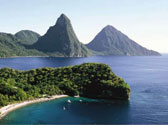 The different inhabitants have all left their mark, this is shown not just in the food and language but also the architecture. In Castries the capital, this is evident in the Cathedral of the Immaculate Conception, which is French in design, but with an African inspired interior and a negro Madonna and Child.
The different inhabitants have all left their mark, this is shown not just in the food and language but also the architecture. In Castries the capital, this is evident in the Cathedral of the Immaculate Conception, which is French in design, but with an African inspired interior and a negro Madonna and Child.
There are plenty of trails and hikes, the interior being made up of rainforest. The British colony was once covered in rainforest, sadly 90% of it was devastated by the timber industry, but what remains is now protected. An excellent series of cycle trails throughout the jungle offers a different perspective.
North of Castries is a big tourist area with rows of hotels. Further along the coast you have Rodney Bay, the Marina is popular with sailors and those who want to be seen. It offers restaurants, shops and banks and general St Lucia ‘glitz and glamour’. The beach is home to more hotels. If you would like to get to know the real St Lucia then stop off at the village of Gros Islet. This sleepy fishing village has wonderful local restaurants, albeit rustic. Nearby beaches are some of the best and they are not overcrowded or spoilt.
Marigot Bay in the South, was made famous for featuring in the 1967 film “Doctor Doolittle”. The beautiful hidden bay is perfect for mooring and hiding away from the crowds. Soufriere was named by the French after the hot springs which were found nearby and are still a popular destination. However the Pitons are what really attracts visitors, the twin volcanic towers of rock are St Lucia’s famous landmark. For the adventurers they can be climbed, but a guide is recommended and it does take a day to summit each peak.
![]() St Vincent and the Grenadines are a beautiful chain of islands which embody everything that is Caribbean; beautiful tropical waters and picture post card islands. St Vincent was ‘discovered’ by Columbus in 1498 on the feast day of the Portuguese patron saint Vincent of Sargossa and so the island was named.
St Vincent and the Grenadines are a beautiful chain of islands which embody everything that is Caribbean; beautiful tropical waters and picture post card islands. St Vincent was ‘discovered’ by Columbus in 1498 on the feast day of the Portuguese patron saint Vincent of Sargossa and so the island was named.
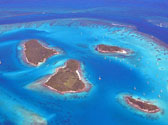 St Vincent itself is a good jumping off point for the other islands, but take the time to explore it. The capital Kingstown is busy with locals going about their business. The architectural harks back to colonial times, you can lose yourself wandering through the cobblestone streets.
St Vincent itself is a good jumping off point for the other islands, but take the time to explore it. The capital Kingstown is busy with locals going about their business. The architectural harks back to colonial times, you can lose yourself wandering through the cobblestone streets.
A trip to St Vincent Botanical Gardens is a wonderful oasis of tranquillity, established in 1762 they are the oldest botanical gardens in the western hemisphere. It is also home to an aviary housing the endangered St Vincent parrot.
The north of the island is in stark contrast to the more touristy south. Black sand beaches, banana plantations and rainforest are all to be found, with the towering, and still active, La Soufriere volcano dominating the horizon. Richmond beach boasts black sand and impressive coast. The interior offers hiking for all levels, the Vermont Nature Trails are a good starting point. Villages are unspoilt and give a flavour of life as an islander. Walliabou Bay and Falls have been made famous by the ‘Pirates of the Caribbean’ films. Much of the sets were left behind and make for an interesting tour.
Vincy Mas is the annual carnival in June and draws a big crowd. Parties, music, live performances and parades are a must see.
![]() Bequia is the first island you get to south of St Vincent. This beautiful little island was once on the trade route so is familiar and welcoming to visitors.
Bequia is the first island you get to south of St Vincent. This beautiful little island was once on the trade route so is familiar and welcoming to visitors.
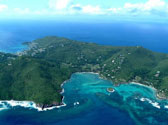 Port Elizabeth, popular with the yachting set, runs along Admiralty Bay, and hosts several shops, restaurants and bars. Fort Hamilton offers panoramic views of the bay and is still home to ancient canon that were used by the British in the 1700’s. Princess Margaret Beach is a beautiful stretch of sand to while away a few hours.
Port Elizabeth, popular with the yachting set, runs along Admiralty Bay, and hosts several shops, restaurants and bars. Fort Hamilton offers panoramic views of the bay and is still home to ancient canon that were used by the British in the 1700’s. Princess Margaret Beach is a beautiful stretch of sand to while away a few hours.
Lower Bay and Friendship Bay, are great places to tune into Caribbean time. Both are sleepy communities with a few restaurants and guest houses on offer.
A visit to the Old Hegg Turtle Sanctuary is informative and allows visitors to get up close to juvenile turtles. The Bequia Maritime Museum gives a wonderful insight into this boat building community, Whale boats and schooners were built in Bequia, and really put it on the map.
“Moon Hole” on the south west corner is a must see! Not only is there a hole in the rock face where at the right time of year you will see the moon rising through the hole, but the surrounding hill side has been carved out to create basic living accommodation linked by staircases. It is an amazing project!
The world famous Regatta takes place at Easter and brings in sailors from around the world.
![]() Mustique conjures up images of the rich and famous who want to get away from it all in paradise. However Mustique was not always so grand. In 1958 there were only 100 inhabitants left, following the European influence leaving the colony, those who stayed had to make a living out of fishing and farming. Fortunes changed when Colin Tennant bought the island and started to invest in its infrastructure, which led to the founding of the Mustique Company that still manages the island today. Sixty years on, the island you see now is a far cry from the shell that had been left from the plantation era.
Mustique conjures up images of the rich and famous who want to get away from it all in paradise. However Mustique was not always so grand. In 1958 there were only 100 inhabitants left, following the European influence leaving the colony, those who stayed had to make a living out of fishing and farming. Fortunes changed when Colin Tennant bought the island and started to invest in its infrastructure, which led to the founding of the Mustique Company that still manages the island today. Sixty years on, the island you see now is a far cry from the shell that had been left from the plantation era.
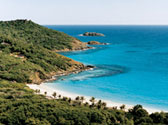 Several old buildings have been restored including the famous Cotton House which is now a boutique hotel. The island offers wonderful snorkelling and diving along with picturesque beaches.
Several old buildings have been restored including the famous Cotton House which is now a boutique hotel. The island offers wonderful snorkelling and diving along with picturesque beaches.
A visit to the famous ‘Basil’s Bar and Restaurant’ is a must, eat, drink and be merry under the thatched restaurant and, if you are lucky, you might rub shoulders with a celebrity or two!
![]() Canouan is an island of two halves. The Raffles Resort and Trump Casino dominate half the island, with privatised beaches offering the visitor so many conveniences, that they never leave the complex. The other half of the island remains unspoilt and quieter, so the independent traveller can enjoy the real Canouan without the Raffles price tag.
Canouan is an island of two halves. The Raffles Resort and Trump Casino dominate half the island, with privatised beaches offering the visitor so many conveniences, that they never leave the complex. The other half of the island remains unspoilt and quieter, so the independent traveller can enjoy the real Canouan without the Raffles price tag.
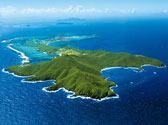 The name Canouan actually comes from the Amerindian name ‘Cannoun’ meaning turtle. Turtles can still be seen at certain times of the year coming ashore to lay their eggs on the sheltered windward beaches. Coastal walks allow the more intrepid visitor to admire the beaches and coves which are not accessible by road.
The name Canouan actually comes from the Amerindian name ‘Cannoun’ meaning turtle. Turtles can still be seen at certain times of the year coming ashore to lay their eggs on the sheltered windward beaches. Coastal walks allow the more intrepid visitor to admire the beaches and coves which are not accessible by road.
The Canouan Regatta in May/June is a festival both on and off the water; boat races, calypso competitions and all manner of festivities take place.
![]() Tobago Cays are, quite simply, breathtaking, consisting of 5 uninhabited islands each with its own coral reef halo. As a national park the islands remain unspoilt. The beaches and waters are out of this world and can be toured in a day. The authorities are keen to keep these cays in their pristine condition. Visitors are asked to be as ‘low impact’ as possible, this means taking away your garbage and using reputable tour guides.
Tobago Cays are, quite simply, breathtaking, consisting of 5 uninhabited islands each with its own coral reef halo. As a national park the islands remain unspoilt. The beaches and waters are out of this world and can be toured in a day. The authorities are keen to keep these cays in their pristine condition. Visitors are asked to be as ‘low impact’ as possible, this means taking away your garbage and using reputable tour guides.
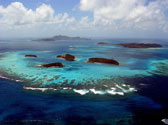 For divers the Mayreau Gardens are stunning coral reefs with a variety of marine life. The warm tropical waters make it even more delightful. The Baradal Turtle Sanctuary is home to the green and hawksbill turtle who can be seen in their natural environment. For those who want to stay above water the Catholic Bird Sanctuary is an excellent place to observe large colonies of sea birds nesting.
For divers the Mayreau Gardens are stunning coral reefs with a variety of marine life. The warm tropical waters make it even more delightful. The Baradal Turtle Sanctuary is home to the green and hawksbill turtle who can be seen in their natural environment. For those who want to stay above water the Catholic Bird Sanctuary is an excellent place to observe large colonies of sea birds nesting.
Petit Tabac has been made famous by the Pirates of the Caribbean-“Curse of the Black Pearl” film. It is also perfect for a picnic on your very own desert island. Petit Bateau, James Bay and Petit Rameau all offer hiking trails. Hikers can observe iguanas, birds and array of flora and fauna on route.
![]() Carriacou is known as the ‘Land of Reefs’ and is how the West Indies was before it was discovered by tourists. It is quiet, restful and full of the soul of Caribbean culture. The island offers wonderful hiking and secluded beaches, Anse La Roche is a hidden paradise which takes a bit of finding but is well worth the visit.
Carriacou is known as the ‘Land of Reefs’ and is how the West Indies was before it was discovered by tourists. It is quiet, restful and full of the soul of Caribbean culture. The island offers wonderful hiking and secluded beaches, Anse La Roche is a hidden paradise which takes a bit of finding but is well worth the visit.
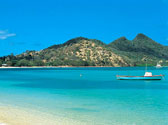 A visit to the Carriacou Museum offers an insight into island life through the ages. Artefacts dating back to the Amerindians, alongside relics from the French and British rules, can all be found here.
A visit to the Carriacou Museum offers an insight into island life through the ages. Artefacts dating back to the Amerindians, alongside relics from the French and British rules, can all be found here.
Carriacou is famous for traditional wooden boat building, a skill which can still be seen today on the beaches. This dates back to the 19th Century when Scottish boat builders settled on the island. Their legacy lives on in local names and boat building skills. The annual Carriacou Regatta is trying to install these skills and enthusiasm into the next generation.
The population, although small, is passionate about its heritage and traditions. This can be seen in the many unique customs still retained today.
![]() Grenada, is the ‘Isle of Spice’, and stands out in recent history for being devastated by Hurricane Ivan and the 1980’s US invasion, the hulks of abandoned Cuban beach landing craft can still be seen in Hogs Bay. The island has made tremendous rebuilding progress and is extremely welcoming to yachting cruisers.
Grenada, is the ‘Isle of Spice’, and stands out in recent history for being devastated by Hurricane Ivan and the 1980’s US invasion, the hulks of abandoned Cuban beach landing craft can still be seen in Hogs Bay. The island has made tremendous rebuilding progress and is extremely welcoming to yachting cruisers.
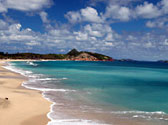 Grenada Island is the largest of the trio which make up ‘Grenada’ with Carriacou and Petit Martinique being the smaller sister islands. The capital St George’s is a mix of colonial and colourful Caribbean buildings. The European influence is ever present in the look and feel of the restaurants and shops. “Ivan” almost destroyed three 19th Century churches; work is still being done to bring them back to their former glory.
Grenada Island is the largest of the trio which make up ‘Grenada’ with Carriacou and Petit Martinique being the smaller sister islands. The capital St George’s is a mix of colonial and colourful Caribbean buildings. The European influence is ever present in the look and feel of the restaurants and shops. “Ivan” almost destroyed three 19th Century churches; work is still being done to bring them back to their former glory.
Grand Anse Beach is home to a strip of hotels catering for all budgets along the superb beach. However, created for tourists, it lacks any real heart. Further down the coast is Morne Rouge Bay which has a far superior beach but is not so popular with the masses.
Grand Etang Road cuts through the forest and gives a totally different aspect to the island. The rainforest boast monkeys, an African import as well as countless birds, reptiles and mammals. Clouds often hang on the mountains giving it a prehistoric feel. With a guide you can also find the spices growing wild which gave Grenada its name ‘Isle of Spice’. Alternatively visit ‘Laura’s Herb and Spice Garden’ for an educational tour of the plants, trees and spices.
Annandale Falls is a popular destination, but try to avoid cruise ship days. The 30ft waterfall drops into a beautiful grotto, surrounded by so much lush vegetation that it is easy to see why it is so popular.
The River Antoine Rum Distillery claims to be the oldest working water mill in the Caribbean and still produces rum to this day. A visit to the Gouyave Nutmeg Factory gives a fascinating introduction into the production of this spice.
To get even further off the beaten track head to Bathways Beach where three small uninhabited islands offer excellent swimming and snorkelling opportunities. Levera Beach is part of the national park scheme where the sea turtle is protected. This part of Grenada feels a world away from Grand Anse.
The cuisine is reflective of the country’s heritage, with the usual West Indian dishes. The national dish is ‘Oil down’ a thick meaty stew. French, Italian and Mexican influences can also be found.
To assist with your planning we offer some suggestions for Accommodation and Travel
We also offer Gift Vouchers to give to family and friends.
FAQs





